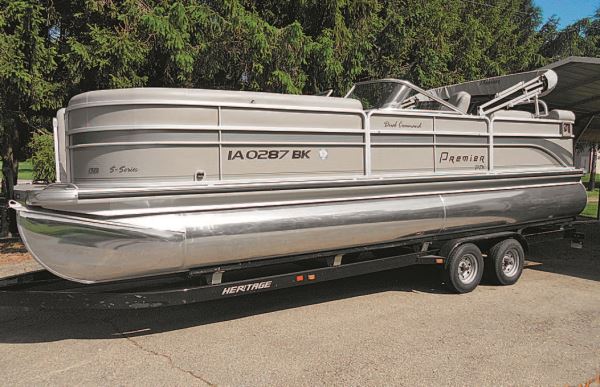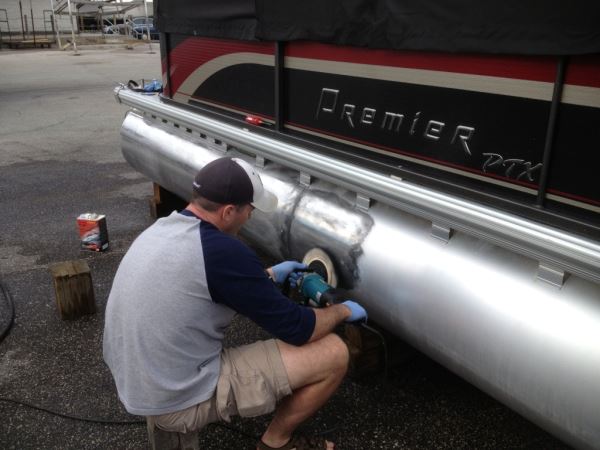 This month I was actually going to share two new layered and colorful pontoon party drinks my wife and I came up with, called the Pon-tini and Tri-tini, but I was following the Pontoon and Deckboat Facebook page about polishing pontoons and decided I had to put my two cents’ worth in. So stop by next month for the party drink recipes.
This month I was actually going to share two new layered and colorful pontoon party drinks my wife and I came up with, called the Pon-tini and Tri-tini, but I was following the Pontoon and Deckboat Facebook page about polishing pontoons and decided I had to put my two cents’ worth in. So stop by next month for the party drink recipes.
Opinions on Facebook about polishing ‘toons ranged from something like “It looks great” to “It’s a great waste of time.” So I thought I’d share my experience especially since I didn’t plan on polishing my ‘toons and I have firsthand experience.
If you ever owned anything that was polished aluminum, you know what it demands of the owner. Being involved with many things aluminum (airplanes, boats, etc.), it took me a while thinking about the cleaning, sanding, acid wash, buffing, washing, wiping of handprints, buffing, more waxing… before I could get motivated to tackle the job. Sure, shiny aluminum looks good but it takes a lot of “elbow grease.” I like using my elbow—that’s why we’re working on a party drink—but not polishing a pontoon.
Last year I thought about buying a boat lift and keeping my ‘toon high and dry to prevent that nasty buildup of our fresh water lake sludge. Well, that thought didn’t last long. New or used, the cost of the lift was more expensive than I thought the value of clean ‘toons was. I asked the local marina to watch for a used lift to keep my boat on and they had a few, but again, the price was pretty high.
I also talked to a couple shops about using bottom paint like I used on my sailboat. Bottom painting was my first thought after the lift. I was used to touching up the ablative type each season or repainting the bottoms. The color was right out of Henry Ford’s playbook: I could get any color bottom paint as long as I wanted black. The bottom paint was a special type available for aluminum boats. There’s not a huge market around here so there’s not a lot of options.
Of course most people thought I was crazy for trying to bottom paint the ‘toons. I can’t tell you how many people gave me advice. Most had the same comments: “Why don’t you acid clean the ‘toons and add shark hide and be happy?” “Just do the same thing every year.” “I did a lot of online research.” Safety tip: be careful of the internet. You can find anything you want to hear on the internet and you don’t really know if it’s good or bad. But one place that I use is the Pontoon and Deck Boat Forum and I’m pretty comfortable with comments listed there. Most of the comments are from boat owners with personal experience. It is amazing how much info you can get from that place.
 So, when I pulled the boat last October I did the typical power wash to clean the ‘toons off and decided I was perfectly happy with the dark stained area at and below the ‘toon’s water line. Anyway, I never liked the idea of acid washing the ‘toons. In theory, it eats away a little bit of the pontoon surface every time, so it has never been something I worried about. Well, all of that changed this year when I decided to add a Vantage pontoon guard and realized that my ‘toons were really stained and dirty. Some might say ugly. An executive decision was made to clean and polish at least the top half of the pontoons down to where the protection guard would be installed.
So, when I pulled the boat last October I did the typical power wash to clean the ‘toons off and decided I was perfectly happy with the dark stained area at and below the ‘toon’s water line. Anyway, I never liked the idea of acid washing the ‘toons. In theory, it eats away a little bit of the pontoon surface every time, so it has never been something I worried about. Well, all of that changed this year when I decided to add a Vantage pontoon guard and realized that my ‘toons were really stained and dirty. Some might say ugly. An executive decision was made to clean and polish at least the top half of the pontoons down to where the protection guard would be installed.
In reality, I probably could have just used a 3M buff pad on the area I was going to glue the Vantage protection strip to and been done, but I guess I really did want to have shinier ‘toons to start the season.
Cleaning and polishing the ‘toons takes just a few products. You need acid wash, water and a hose, a few old rags, buffer and pads, and aluminum polish. Don’t forget safety equipment like gloves and eye protection when you apply the acid wash. Also get drop cloths (plastic sheets) to cover the trailer or anything else that might get damaged by the drips when you are spraying the wash. You might need a fine grit 3M pad to get rid of some of the really tough corrosion and dirt. Now is also a good time to sand down any sharp-edged nicks in the ‘toons.
I’ve used all kinds of boat products and always had good luck with Star Brite. So for this project I bought Star Brite Ultimate Aluminum Cleaner/restorer. I’m not too worried about the inside of the ‘toons shining so I only bought one container which was more than enough. I’m also not worried about picking up a few knots (or mph) with shiny slick pontoons. With my pontoon, I’m just cruising around enjoying the water and fresh air; a couple miles per hour or a mile per gallon more isn’t really a big deal for me.
If you haven’t used aluminum cleaner (acid wash) before it’s actually very easy and quick. Spray it on, let it set for a few minutes and rinse it off. Of course, you need to protect your trailer and anything that’s under the dripping acid while you spray and rinse. A small warning: if you were excepting the aluminum to look like a new, shiny, mirror-finished product, it won’t. Once you’re done, the cleaner will usually turn the dark stained aluminum back to kind of a white-looking aluminum color, lacking the shine.
 This is when the work starts. I dug out my Makita electric grinder/polisher with a couple of brand new wool buffing pads to go to work making my ‘toons shine. Don’t have a big polisher? No problem. If you have a cordless or corded drill, backing plate and a couple buffing pads, you have a buffer. It just takes longer because of the lower power and smaller size. It’s also important to note that if you have been washing the ‘toons with the hose and there is water all over the area where you are working, using an electric buffer and standing in water can be a bad experience. Let the area dry before you start the polishing phase.
This is when the work starts. I dug out my Makita electric grinder/polisher with a couple of brand new wool buffing pads to go to work making my ‘toons shine. Don’t have a big polisher? No problem. If you have a cordless or corded drill, backing plate and a couple buffing pads, you have a buffer. It just takes longer because of the lower power and smaller size. It’s also important to note that if you have been washing the ‘toons with the hose and there is water all over the area where you are working, using an electric buffer and standing in water can be a bad experience. Let the area dry before you start the polishing phase.
There are many different types of metal polish but I used White Diamond Metal Polish and Sealant. Apply the polish with a cloth to a small section of the ‘toon (I worked about a two foot section at a time) and use the buffer/polisher to shine your ‘toon. Be prepared for your hands, arms and clothes to get a black greasy residue all over. The combination of the polish, the aluminum and grime fling everywhere. It’s basically water soluble but it’s kind of messy. Another safety tip: wear gloves and a shop apron and most of all, eye protection!
After the polishing I wiped down the ‘toons and removed the black leftover residue with a cloth and water rinse. And best of all, I was able to shine the outside of my ‘toons in a couple hours from start to finish.
It was a pretty simple weekend project that can be done in your driveway or even at the marina if you have access to water and electricity. Of course, not while the ‘toon is still in the water…duh.
Will I polish them again next year? Probably not. Although it does look cool having shiny pontoons. Never say never!

